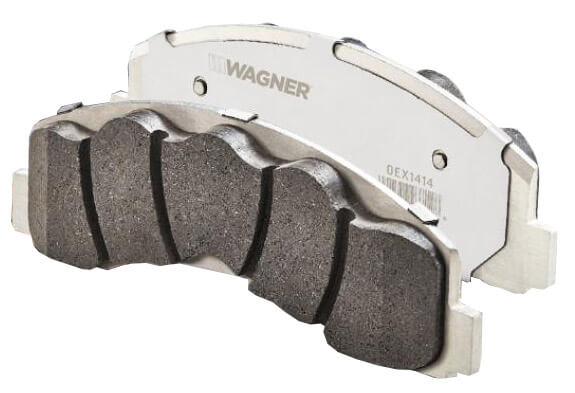Ceramic brake pads — are they the right choice for your vehicle
The advantages and disadvantages of ceramic brake pads
The majority of cars and CUVs now come equipped with

Wagner OEX brake pads are a great example of a high quality ceramic pad built on a galvanized steel backing plate for long life
ceramic brake pads, as opposed to organic or semi metallic pads used in the past. Carmakers choose ceramic brake pads because they’re quiet, easy on the rotors and create less brake dust. But that doesn’t mean they’re the best brake pads for all vehicles. Here’s why carmakers switched to ceramic
What’s in a ceramic brake pad?
Ceramic pads are made mineral, aramid, and ceramic fibers, fillers, adhesives and metallic particles. These materials help the pad generate and dissipate heat better than other pad types.
They stop your vehicle using Adherent versus Abrasive friction
Adherent friction is much different than abrasive friction. Adherent friction involves deposit a film of the friction material on to the rotor. This “transfer layer” is what you deposit during the break-in (also called burnishing) period right after installing the new brake pads.
Once the transfer layer is in place, all future braking is accomplished pressing the pad’s friction material against the transfer layer. This generates high heat which disintegrates the transfer layer and at the same time deposits a fresh layer of material onto the rotor face.
Abrasive friction, on the other hand relies on creating heat by rubbing an abrasive pad against a bare metal rotor. Abrasive brake pad technology is more like sandpaper against wood. In other words, the friction material abrades the rotor. Semi-metallic brake pads fall into this category, which is why they wear out rotors faster than ceramic brake pads. They also make more noise and create more brake dust.
Ceramic pads have less stopping power than semi-metallic pads
That surprises a lot of people, but it’s a fact. Once semi metallic pads heat up, they stop better than any other type of friction material. That’s why they’re still installed on light trucks and large SUVs.
No. There are lots of Federal regulations for the brake parts that come on a new car. But there are NO federal regulations for aftermarket brake parts and there are no industry standards for the term “ceramic brake pads.” So the quality of ceramic brake pads vary widely among different manufacturers. In fact, brake pad quality can vary even within the same brand. That’s because most brake parts manufacturers offer an economy, OEM and premium version of their products.
There are advantages and disadvantages to ceramic friction materils
Here are the pros:
• Ceramic friction provides quieter braking, emitting a noise that is above the normal human range of hearing.
• By using adherent versus abrasive friction, ceramic brake pads reduce rotor wear and as a result, produce less brake dust on your wheels.
• The ceramic fibers dissipate heat exceptionally well to reduce brake fade
• They’re more resistant to salt and water than semi metallic friction material
And the cons:
They’re the most expensive option.
They produce less braking power than semi metallic pads
They’re not recommended for heavy-duty applications like hauling because they require greater pressure to get the same stopping power
They can encounter more brake fade during hard braking than semi metallic pads
Which brake pad friction material should you choose?
Generally speaking, you should stick with the type of brake pad that came on your vehicle from the factory. If you change to a different brake pad chemistry, you will get different braking performance. If your vehicle came with semi-metallic brake pads and you switch to ceramic, you’ll have LESS braking power. That’s an issue if you have a truck or haul heavy loads.
©, 20201 Rick Muscoplat
Posted on by Rick Muscoplat
